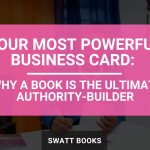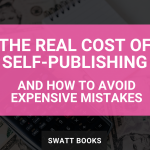Congratulations! You’ve written and published a professional-quality book. But this is just the beginning. Being a successful author is a marathon, not a sprint. The real journey begins now. In today’s noisy world, where we’re constantly bombarded with messages, standing out requires a robust, long-term book marketing strategy to remind your ideal reader that your book exists and is the solution they need.
In this blog, we’ll explore key marketing strategies to promote your book, boost your business, and establish your profile as an industry expert.
Social Media: Your Powerful Ally
Social media is a powerful tool for book marketing, accessible to nearly everyone and capable of significant impact with minimal financial investment. However, it requires careful planning and strategy.
Choosing the Right Platform: Not all social media platforms are the same. Each caters to different demographics and interests. For example, TikTok appeals to a younger audience, while LinkedIn is more business-focused. Identify where your target audience spends their time and focus your efforts there.
Setting Up Author Profiles: Create engaging, professional profiles on your chosen platforms. Use a professional photograph, write a compelling bio, and include links to your website and book’s landing page. Starting from scratch may take time, but a well-planned strategy can lead to rapid growth.
Content Strategy: A clear content strategy is crucial. Align your content with your book’s theme and make it interesting for your target readers. Maintain a mix of content types, such as book teasers, author insights, and industry-related posts. Follow the 80/20 rule: 80% value-driven content, 20% promotional.
Consistency is Key: Consistency is vital. Social media algorithms favour channels that regularly deliver valuable content. Develop a posting schedule you can maintain long-term, even if it’s just 2-3 times a week. Use batch creation and pre-scheduling tools to help maintain consistency.
Engagement and Interaction: Social media is about being social. Engage with your audience by responding to comments and messages. This builds loyalty and creates a sense of community, encouraging readers to reach out for support.
Visual Content: Visual content captures attention more effectively than text alone. Invest time in creating high-quality images, videos, and infographics using tools like Canva, Unsplash, and Descript.
Paid Advertising: While social media is free, paid advertising options like PPC and boosted content can amplify your reach. Start organically to understand what works, then consider investing in paid options.
Managing Time and Resources: Social media can be a time-suck. Schedule content in advance and allocate specific times for engagement to avoid being overwhelmed.
Public Relations (PR)
PR is crucial for gaining exposure, credibility, and a wider readership, especially for lesser-known authors. Here are four primary PR tools:
Traditional Press Coverage: Traditional media like newspapers and television can still play a significant role. Create compelling press releases and reach out to relevant journalists. Ensure your other marketing activities reinforce your credibility as an expert.
Blog Tours: Collaborate with bloggers who share your audience to feature your book. Guest articles, interviews, and reviews can reach niche audiences and enhance online visibility.
Author Interviews: Interviews allow readers to connect with you personally. Opportunities include TV, radio, podcasts, YouTube, blogs, and live events. Prepare talking points and focus on providing value, not just sales pitches.
Book Events: Book launches, readings, and signings offer face-to-face interaction with readers, strengthening your relationship with them. Promote these events as you would any other to maintain visibility and credibility.
Speaking Engagements
Public speaking can significantly boost your credibility. There are two main types: guest-speaking events and author-run events.
Guest Speaking: Speaking at conferences, seminars, and industry events taps into the reach and credibility of the organizers. Start by networking with event managers and pitch yourself as a speaker.
Author-Run Events: Host your own book launches, workshops, and webinars. These events allow you to control all aspects, reinforcing your brand. They can generate revenue through ticket and book sales.
Becoming a Good Speaker: Connect with your audience through body language, eye contact, and storytelling. Tailor your content to your audience and consider public speaking training or joining groups like Toastmasters.
Advertising & PPC
Paid advertising, when done correctly, can complement your organic marketing strategy. There are three main platforms to consider: Google, social media, and Amazon.
Google Ads: Effective for reaching potential readers searching for relevant content. Successful campaigns rely on carefully selecting target keywords and bidding strategies.
Social Media Advertising: Platforms like Facebook and Instagram offer demographic targeting. Craft compelling ad content that speaks directly to your audience.
Amazon Ads: Amazon allows targeting by keywords and competitor books, making it highly effective for visibility in competitive categories.
Ad Content & CTA: Craft compelling headlines and ad copy with a clear call-to-action (CTA). Use A/B testing to refine your campaigns for maximum effectiveness.
Courses, Webinars, & Upsells
Publishing a business book can lead to diversified income streams like courses, workshops, and webinars. These provide additional revenue and opportunities to upsell your services.
Online Courses: Develop a carefully planned curriculum that complements your book. Consider the logistics of hosting, payment, and access control.
Workshops & Webinars These require less time to prepare and can be delivered repeatedly. Tailor your content to the audience and event.
Pricing Strategies: Offer competitive pricing using one-time payments, subscriptions, or bundles. Use the one-to-many multiplier to maximize revenue.
Upsells: Use your book and training sessions as opportunities to offer additional resources or services, fostering long-term customer retention.
Free Copy Giveaways
Giving away free copies of your book can build brand awareness, expand your audience, and establish credibility. Be strategic about when and to whom you give copies.
Pre-Publication: Give copies to influential figures for reviews to build social proof.
Launch: Generate word-of-mouth hype by giving copies to your network, and encouraging them to talk about your book.
Ongoing: Use giveaways as part of your ongoing marketing activities to attract opportunities and cement collaborations.
Measuring ROI
Measuring the ROI of your book involves tracking both marketing and publishing costs. Calculate whether book sales cover promotional expenses and assess intangible benefits like increased credibility and new business opportunities.
Marketing Costs: Track money spent on marketing and compare it to book sales revenue.
Publishing Costs: Include editing, design, and production costs. Assess the broader impact on your business, such as new clients and increased credibility.
Next Steps
By implementing these strategies, you can maximize the impact of your book and establish yourself as a go-to expert in your field. Ready to take the next step? Pre-order your copy of my latest book “THE WRITE STRATEGY: A No-Nonsense Guide to Boosting Your Thought Leadership Through Publishing” and continue your journey to becoming a successful author and business leader.





